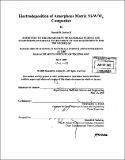Electrodeposition of amorphous matrix Ni-W/Wp̳ composites
Author(s)
Jenket, Donald R. (Donald Robert)
DownloadFull printable version (2.882Mb)
Other Contributors
Massachusetts Institute of Technology. Dept. of Materials Science and Engineering.
Advisor
Christopher A. Schuh.
Terms of use
Metadata
Show full item recordAbstract
An amorphous Ni-W alloy matrix was incorporated with W particulate through two types of electrodeposition. The plating bath for the electrodeposition contained nickel sulfate, sodium tungstate, sodium citrate, ammonium chloride, and a variable amount of 1 gm tungsten particulate ranging in concentration from about 5g/L to 15g/L.The first method was electrodeposition with only moderate stirring of the plating bath. The second method had a forced flow of solution on the substrate via a pump. The results showed incorporation in both methods, but the flowed method resulted in more incorporation. The amount of incorporation increased with the amount of particulate in solution until a limit that lies somewhere between 10g/L and 15g/L of particle concentration. At this point, the incorporation became hindered by the excess amount of particulate in solution. It was also shown that an increase of particulate concentration caused more voids in the material, and the flowed method caused less voids than the normal method. A tapering in the amount of incorporation between the substrate side and the surface side of the deposit was observed; the area close to the substrate had a higher incorporation than the area near the surface. Hardness testing showed mechanical property differences through the thickness of the deposit with the area near the substrate being softer than the area near the surface. Compression testing showed an increase in the strain and a decrease in the stress before failure, suggesting an improvement in ductility.
Description
Thesis (S.B.)--Massachusetts Institute of Technology, Dept. of Materials Science and Engineering, 2005. In title on t.p., double-underscored "p" appears as subscript. Includes bibliographical references (p. 17).
Date issued
2005Department
Massachusetts Institute of Technology. Department of Materials Science and EngineeringPublisher
Massachusetts Institute of Technology
Keywords
Materials Science and Engineering.